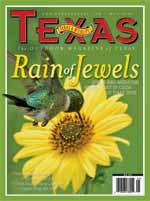
Island Building
About 2,000 acres of new bird habitat have been created out of dredge material.
By Marsha Wilson Rappaport
Galveston Island has a small new neighbor: Evia Island. Evia Island is no competition for the Strand or the seawall since no human tourists are allowed on its six-acre site near Bolivar Peninsula. Instead, its 250-foot sand beach serves as a water bird wildlife sanctuary. Since it was completed in summer of 2000, it’s been a “no-human” zone which has welcomed thousands of terns, skimmers, pelicans and other waterfowl to “drop in and set a spell” in the warm Texas sun.
What makes Evia island special is that it is man-made and part of the Beneficial Uses Group project. The project is committed to building more than 4,250 acres of marsh over the next 50 years from the “spoils” produced when Galveston Bay is dredged to increase its depth in order to improve maritime traffic.
According to the Environmental Protection Agency, the U.S. has lost 55 million acres of wetlands. Galveston Bay has lost 85 percent of its native sea grass meadows. The losses are due to a combination of man-made and natural causes. Wetlands are nurseries for many types of marine life — when the wetland disappears, there’s no place for the marine animals to produce and nurture the next generation. The ecosystem that has made Galveston Bay the seventh largest estuary system in the country is being lost. And solving a problem this massive requires a cooperative effort between citizens and government agencies.
The project is a joint venture with eight agencies, including the Texas Parks and Wildlife Department, the Texas General Land Office, the Port of Houston Authority, the U.S. Army Corps of Engineers, the U.S. EPA, the National Marine Fisheries Service, the U.S Fish and Wildlife Service and the Natural Resource Conservation Service.
“As owner of all state submerged lands, the Land Office had a real stake in finding a better way to use the materials dredged up from the ship channel,” says Jerry Patterson, Commissioner of the Texas General Land Office.
“The result has been a success that’s being held up nationwide. Dredge material, once called spoil, now is being put to a beneficial use in building up bird habitat and generally improving the bay ecosystem,” says Patterson.
“In terms of environmental success, we’ve already constructed close to 2,000 acres of habitat,” says Scott H. Aspelin, project manager for the Port of Houston Authority. “There is construction success, economic success and biological/habitat success.”
That acreage includes seven sites scattered throughout the Galveston Bay system including Evia Island.
Andy Sipocz, a natural resource biologist for TPWD, has been with the project since its inception.
“We’ve met once a month since 1990,” says Sipocz. “I quickly realized while working with the engineers that we were speaking two completely different languages.”
Over time, the biologists and engineers figured out how to work together. For example, Sipocz related how tough it was to find the right elevations for the marsh islands.
“The marshes had to be the right elevation,” he says. “If they were planted too deep the plants would die, and if they were planted too high they couldn’t serve as a habitat for fish.”
A solution was devised by combining the survey data used by the engineers with the biological information — such as the effect of water depth on barnacles — in order to build the marshes correctly.
Like many similar projects, funding remains a nagging issue. “Since 75 percent of construction costs are federally funded through the Corps of Engineers, congressional funding is requested annually but not guaranteed. This presents challenges for the project team to be able to build the necessary elements of the project in the time needed with limited or reduced dollars,” says Aspelin.

